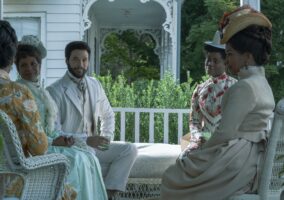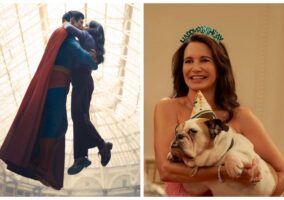 Angelina Jolie in Disney Pictures’ “Maleficent”
Angelina Jolie in Disney Pictures’ “Maleficent”
“Let us tell an old tale anew,” the ever-present and somewhat talkative narrator intones at the start of Disney’s Maleficent. But by the time we got to the story’s end, we wondered if it was really worth the bother. Like 2012’s Snow White and The Huntsman, Maleficent attempts to take a more nuanced look at an old and (by design,) simplistic tale, in that “everything you know is wrong”manner. Like Broadway’s “Wicked,” it attempts to turn a classic villain into a hero – or at least, a villain that cries and has motivations beyond the acquisition of power or the destroying of annoyingly perfect little girls.
It’s an apparently irresistible thing to modern audiences; this retelling of fairy tales and childhood stories by layering them with darkness and angst; meaning and themes. The Tolkienization of Disney. And we’re not sure it’s to the story’s benefit. Fairy tales are supposed to be relatively simple stories populated by characters with the kind of motivations that children can understand. They evolved over time, but they always served the same purpose (outside of entertainment): to teach the very young about difficult concepts like evil and anger and jealousy and to reinforce a basic moral code about goodness and love and family – and also to not trust strangers or go wandering through the woods. Purely universal childhood themes that still resonate centuries after the original stories were devised. Classic old fairy tales were shockingly dark, so the basic idea behind the darkening and deepening concept of this film might’ve worked – except we’re talking specifically about Disney characters. And we’re not sure adding paper-thin rape metaphors is something that needed to be done to the Disney version of Sleeping Beauty.
But we’ll say this: it’s stunning to look at. Although someone probably should’ve been told to pull back on the digital effects throttle, because there are times when the visual noise of the film becomes an overwhelming melange of colors and movement; a videogame on acid. We’d have been foolish to expect the film to look anything like the clean, moody, mid-Century-influenced 1959 animated version, but the production design, while amazing, could’ve benefited from some editing with an eye toward that aesthetic. The land of Maleficent, called “The Moors” (which is a darker, edgier, more 2014 way of saying “Fairy Land”) looks like a commercial for a children’s cereal at times. But it’s Disney, so we suppose that’s to be expected. Truly the greatest special effect is Angelina Jolie herself, who gets a little bit of help from prosthetics and some digital trickery and a lot of help from the costume department (who should get well-deserved Oscar nominations – just for the python-skin turban alone), all of which combine to create an entity so amazing to look at that we audibly gasped a couple of times in the theater.
Granted, we’re known to gasp, but still. This was drag on a high level. This was the stratosphere of drag.
And Angelina tears it up, having more fun with this role than anything we’ve seen her do in years. There were times when we wished she could’ve really let loose, because it felt like the script – which required her to go from romantic to demonic to maternal (and sometimes back again; and sometimes all in the same scene) – was holding her back by giving the character far too many conflicting motivations and sudden character turns. In short, when the script calls for Maleficent to be a bitch, she, and by extension, the whole movie, comes alive. When tears streak her prosthetic-enhanced cheeks and the fire literally goes out in her eyes, everything kind of grinds to a halt. And yes, you read those descriptors correctly: romantic and maternal. Weepy mother-daughter and scorned lover drama slathered onto a standard evil witch character – because apparently, these are the only ways you can make a female character more interesting: break her heart, rape her, and make sure she loves children by the time its all over.
Oh, yes. Revisionism. BIG TIME. Consider yourself prepared.
And it’s a shame, because they could’ve had some real fun with her. At the start of the film she’s something like a combination of Gandalf and Luke Skywalker for her people and by the end of the film, she’s kicking ass in a leather catsuit like a superhero. It’s all too much and perhaps a bit too silly, but it was much more interesting to see this character with agency and real motivation; actually doing things for a reason – for good reasons. And besides, she’s terrifying at times. People want to see Maleficent be bitchy and badass. And while the film does give you those moments, there aren’t enough of them for it all to hang together – and they’re broken up by the aforementioned motherhood, rape, and heartbreak themes that only serve to weaken the character and the story. Oh, and Elle Fanning is asked to smile repeatedly, but that’s about it. By design, her character is paper thin. Aurora already got her version of the story, so that makes a certain amount of sense, but given how much the story rests on characters loving or hating her, it would’ve been nice if we could have gotten a better sense of who she is. She’s got a great smile and everyone loves her as soon as they meet her. That’s about all you get.
If you love the Disney version of Sleeping Beauty, you’ll probably enjoy this film, and if you love watching Angelina Jolie be more Angelina Jolie than you ever thought possible, you’ll also probably enjoy this film. But if you’re looking for a ripping good story or an interesting new twist on an old one, you’ll probably leave disappointed and frustrated. There are times when it’s fun, but it’s never as fun as it could’ve and should’ve been.
[Photo Credit: Walt Disney]
Your Friday Dose of Prince Harry Next Post:
Orphan Black: Knowledge Of Causes, And Secret Motion Of Things
Please review our Community Guidelines before posting a comment. Thank you!



